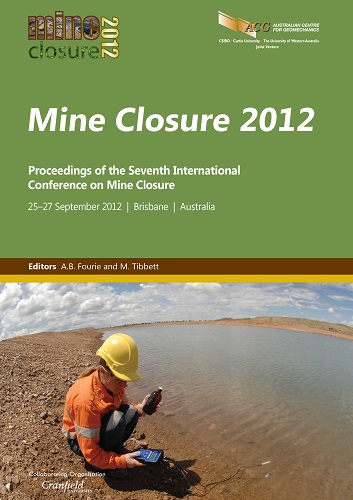Mine closure through the 21st Century looking glass

|
Authors: Digby, C Paper is not available for download Contact Us |
DOI https://doi.org/10.36487/ACG_rep/1208_04_Digby
Cite As:
Digby, C 2012, 'Mine closure through the 21st Century looking glass', in AB Fourie & M Tibbett (eds), Mine Closure 2012: Proceedings of the Seventh International Conference on Mine Closure, Australian Centre for Geomechanics, Perth, pp. 33-38, https://doi.org/10.36487/ACG_rep/1208_04_Digby
Abstract:
The outstanding challenge for mine closure practitioners is how to work with communities to ensure that they are equipped for life after mining – whether or not they continue to live in the shadow of the old mine. Community ownership of what happens when the mine closes is critical. This paper provides a personal viewpoint on some of the key elements of the planning process that might help move us in the direction towards successful mine closure.
References:
Cadbury, D. (2010) Chocolate Wars From Cadbury to Kraft: 200 Years of Sweet Success and Bitter Rivalry, Harper Press.
Fuller, R.B. (1981) Critical Path, St Martins Press, USA.
ICMM (2008) The International Council on Mining and Metals. Planning for Integrated Mine Closure: Toolkit, London, UK.
IIED (2002) International Institute for Environment and Development. Breaking New Ground: Mining, Minerals and Sustainable Development, Earthscan, London.
IFC (2012) International Finance Corporation. IFC Performance Standards on Environmental and Social Sustainability – Effective January 1, 2012, sustainability/publications/publications_handbook_pps.
Li, S., Jordanova, M. and Lindenberger, U. (1998) From good senses to good sense: A link between tactile information processing and intelligence, Intelligence, Elsevier.
Porritt, J. (2005) Capitalism as if the world matters, Earthscan, London.
© Copyright 2025, Australian Centre for Geomechanics (ACG), The University of Western Australia. All rights reserved.
View copyright/legal information
Please direct any queries or error reports to repository-acg@uwa.edu.au
View copyright/legal information
Please direct any queries or error reports to repository-acg@uwa.edu.au